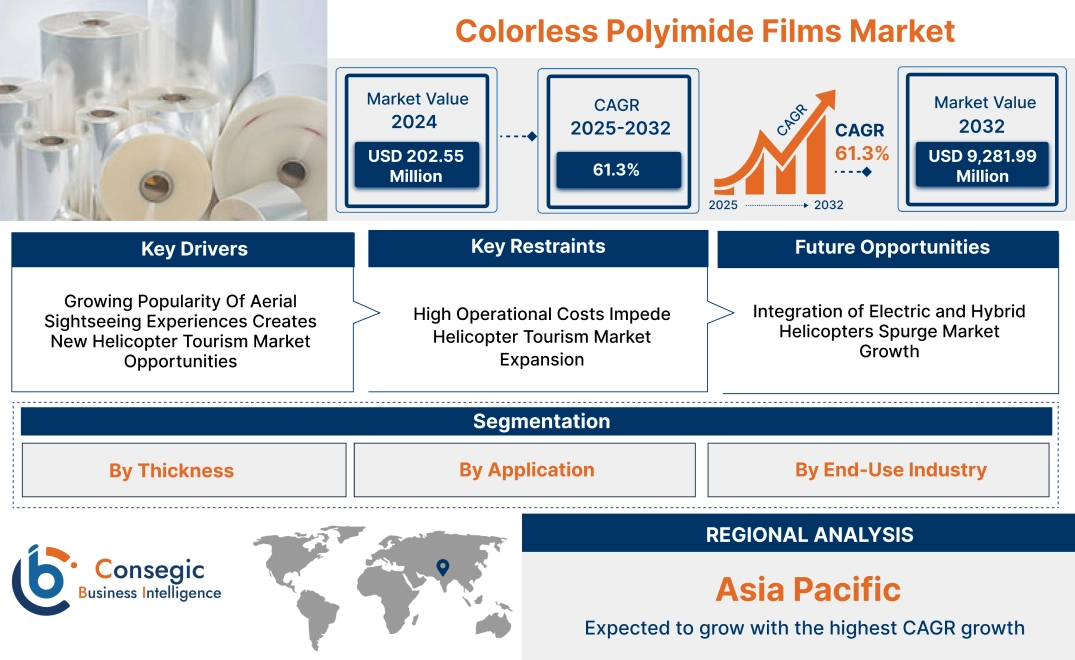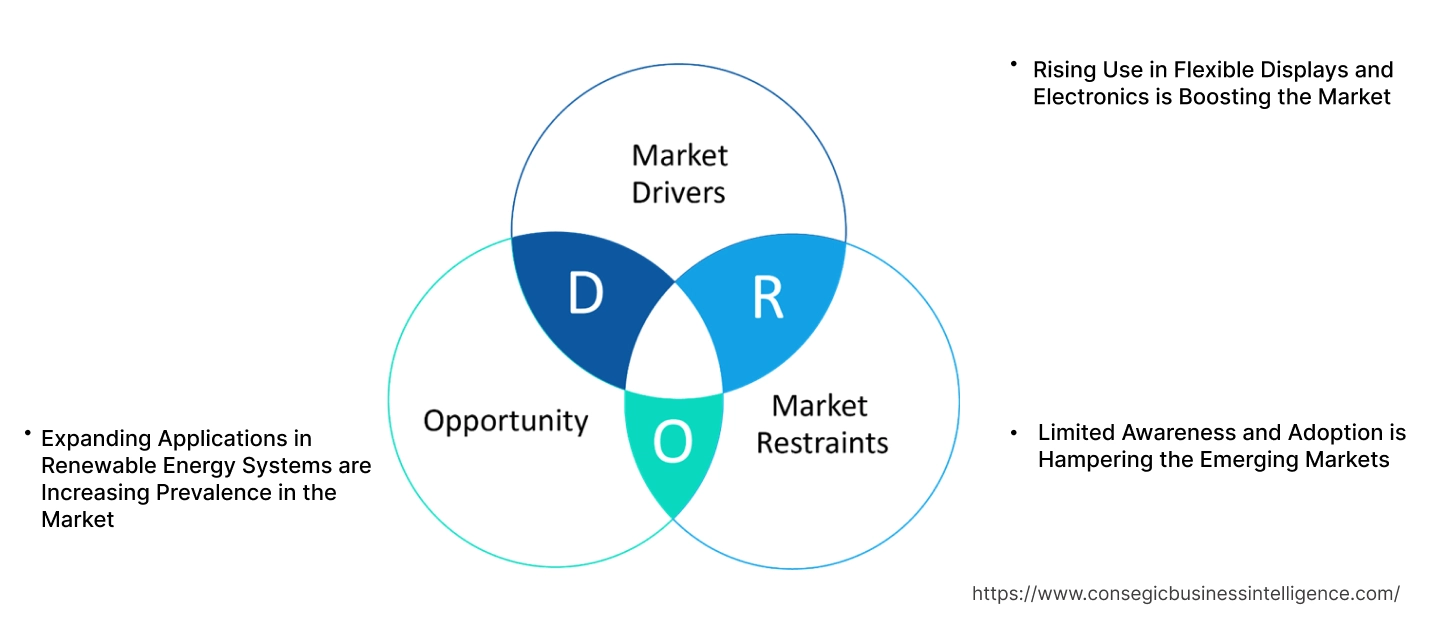- Summary
- Table Of Content
- Methodology
Colorless Polyimide Films Market Size:
Colorless Polyimide Films Market size is estimated to reach over USD 9,281.99 Million by 2032 from a value of USD 202.55 Million in 2024 and is projected to grow by USD 323.10 Million in 2025, growing at a CAGR of 61.3% from 2025 to 2032.
Colorless Polyimide Films Market Scope & Overview:
The colorless polyimide films are advanced, high-performance transparent films offering exceptional thermal stability, flexibility, and optical clarity. These films are widely used in industries such as electronics, aerospace, and automotive, where lightweight, durable, and transparent materials are essential. Key characteristics of colorless polyimide films include high mechanical strength, resistance to extreme temperatures, and excellent electrical insulation properties, making them ideal for flexible displays, solar panels, and circuit boards. The benefits include reduced device weight, enhanced durability, and improved efficiency in demanding applications. Applications span flexible electronics, optoelectronics, photovoltaic cells, and insulation layers for aerospace and automotive components. End-users include electronics manufacturers, aerospace companies, and energy firms, driven by increasing demand for flexible and transparent materials, advancements in electronic devices, and the growing focus on lightweight and sustainable solutions.
Key Drivers:
Rising Use in Flexible Displays and Electronics is Boosting the Market
Colorless polyimide films are increasingly utilized in the electronics sector for their unique combination of optical transparency, mechanical flexibility, and thermal stability. These properties make them indispensable in the production of flexible displays, foldable smartphones, and wearable devices. Unlike conventional materials, colorless polyimide films allow for innovation in design while maintaining the durability and reliability required for high-performance electronic components.
Trends in consumer electronics innovation are driving the adoption of advanced materials to support lightweight and compact designs. These films also play a key role in enabling high-resolution displays and foldable screens, catering to the market's push for technological sophistication. Analysis highlights that their application is expanding as manufacturers seek solutions to meet evolving colorless polyimide films market trends in portability and functionality.
Key Restraints:
Limited Awareness and Adoption is Hampering the Emerging Markets
Despite their benefits, colorless polyimide films face challenges in emerging markets due to limited awareness and accessibility. Industries in these regions often rely on traditional materials, which are more affordable and familiar to local manufacturers. This reliance, coupled with the higher costs associated with colorless polyimide films, restricts their penetration in cost-sensitive and underdeveloped economies.
Trends in industrial modernization and regional advancements in electronics manufacturing are beginning to bridge this gap. However, significant efforts in education, outreach, and cost optimization are required to improve adoption rates. The analysis underscores the importance of building awareness and offering competitive pricing to unlock the market potential in these regions.
Future Opportunities :
Expanding Applications in Renewable Energy Systems are Increasing Prevalence in the Market
The renewable energy sector is increasingly exploring the use of colorless polyimide films in applications such as photovoltaic cells, flexible solar panels, and energy storage devices. These films provide excellent thermal and mechanical properties, enabling more efficient energy capture and storage solutions. Their durability under extreme environmental conditions makes them ideal for enhancing the lifespan and performance of renewable energy systems.
Trends in clean energy and sustainable infrastructure development present significant opportunities for to contribute to the global colorless polyimide films market energy transition. Analysis suggests that manufacturers focusing on tailoring these materials for energy applications, such as improving transparency and efficiency for solar panel use, can capitalize on emerging colorless polyimide films market opportunities in the renewable energy market.
Colorless Polyimide Films Market Segmental Analysis :
By Thickness:
Based on thickness, the flexible substrate market is segmented into less than 10 µm, 10-25 µm, and more than 25 µm.
The 10-25 µm segment accounted for the largest revenue in colorless polyimide films market share in 2024.
- The 10-25 µm thickness range is widely adopted due to its optimal balance between flexibility and durability.
- These substrates are extensively used in flexible displays and flexible printed circuit boards (FPCBs), providing the necessary mechanical strength while maintaining a thin profile.
- Their ability to withstand thermal and mechanical stress has made them a preferred choice in the electronics and automotive sectors.
- The rising production of consumer electronics, such as smartphones and wearable devices, coupled with their use in lightweight automotive displays, has propelled the colorless polyimide films market demand for substrates in this thickness range.
The less than 10 µm segment is anticipated to register the fastest CAGR during the forecast period.
- Substrates with a thickness of less than 10 µm are gaining popularity due to their superior flexibility and lightweight characteristics.
- These ultra-thin substrates are essential in next-generation applications, such as ultra-thin displays and advanced medical devices, where space constraints and high performance are critical.
- The growing trend toward miniaturization in electronics and healthcare equipment, along with advancements in manufacturing technologies, is expected to drive rapid growth in this segment.
By Application:
Based on application, the flexible substrate market is segmented into flexible displays, flexible printed circuit boards (FPCBs), solar cells, lighting equipment, and others.
The flexible displays segment accounted for the largest revenue of 27.40% in colorless polyimide films market share in 2024.
- Flexible displays are the leading application of flexible substrates, driven by their widespread use in consumer electronics such as smartphones, tablets, and wearable devices.
- Flexible substrates enable the production of lightweight, bendable, and durable displays, meeting the growing demand for innovative and portable devices.
- The increasing adoption of foldable and rollable display technology in smartphones and automotive infotainment systems has further strengthened the dominance of this segment.
- Moreover, the integration of flexible displays in smart home devices and commercial applications has contributed to its growth.
The solar cells segment is anticipated to register the fastest CAGR during the forecast period.
- Flexible substrates in solar cells are gaining traction due to their lightweight and adaptable properties, enabling integration into various surfaces, including building facades, rooftops, and portable energy solutions.
- The rising focus on renewable energy and advancements in flexible photovoltaic technology, such as organic and thin-film solar cells, are driving colorless polyimide films market demand in this segment.
- Flexible solar panels are increasingly used in off-grid applications, wearable electronics, and electric vehicles, further propelling colorless polyimide films market growth.
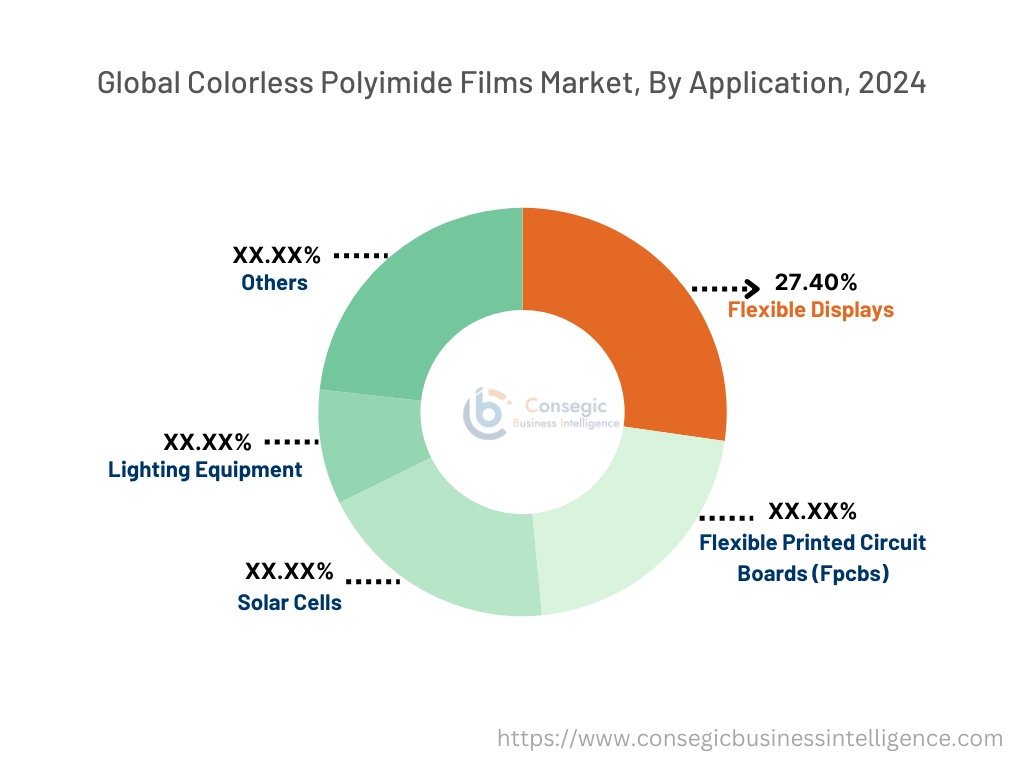
By End Use Industry:
Based on end-use industry, the flexible substrate market is segmented into electronics, aerospace, automotive, healthcare, and energy.
The electronics segment accounted for the largest revenue share in 2024.
- The electronics sector is the largest consumer of flexible substrates due to their application in a wide range of devices, including smartphones, tablets, and wearable gadgets.
- Flexible substrates in smartphones are used to produce foldable screens and compact, lightweight internal components, meeting the trends for innovative and high-performance devices.
- In wearable devices, these substrates contribute to sleek designs and durable electronics, supporting the growing market for smartwatches, fitness trackers, and health monitors.
- Tablets with flexible displays and advanced electronics further enhance the segment’s growth, driven by colorless polyimide films market trends for multi-functional portable devices.
The automotive segment is anticipated to register the fastest CAGR during the forecast period.
- The automotive sector is witnessing a surge in the use of flexible substrates for displays and electronic components in electric vehicles (EVs).
- Electric vehicles benefit from lightweight and compact substrates, which improve energy efficiency and support battery management systems.
- Flexible substrates are also increasingly used in automotive displays for infotainment systems and digital dashboards, enhancing interior aesthetics and functionality.
- The rising production of EVs and the growing trend toward connected and autonomous vehicles are expected to drive significant colorless polyimide films market growth in this segment.
Regional Analysis:
The regions covered are North America, Europe, Asia Pacific, the Middle East and Africa, and Latin America.
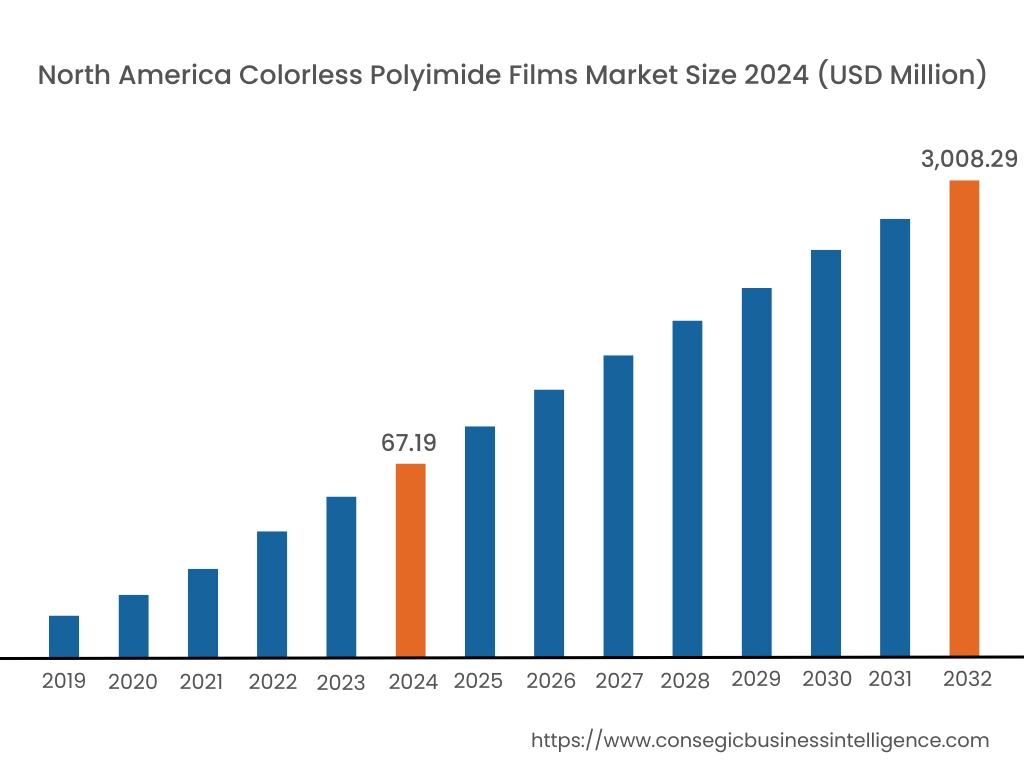
In 2024, North was valued at USD 67.19 Million and is expected to reach USD 3,008.29 Million in 2032. In North America, the U.S. accounted for the highest share of 71.30% during the base year of 2024. North America holds a significant share in the colorless polyimide films market analysis, driven by advancements in the electronics, aerospace, and automotive industries. The U.S. dominates the region, with strong trends for flexible and transparent polyimide films in applications such as foldable displays, flexible circuits, and photovoltaic cells. The growing emphasis on lightweight and durable materials in aerospace and defense also supports the adoption of colorless polyimide films. Canada contributes by increasing its use in renewable energy applications, particularly in solar panels. However, the high production cost of advanced polyimide films may pose challenges for broader adoption.
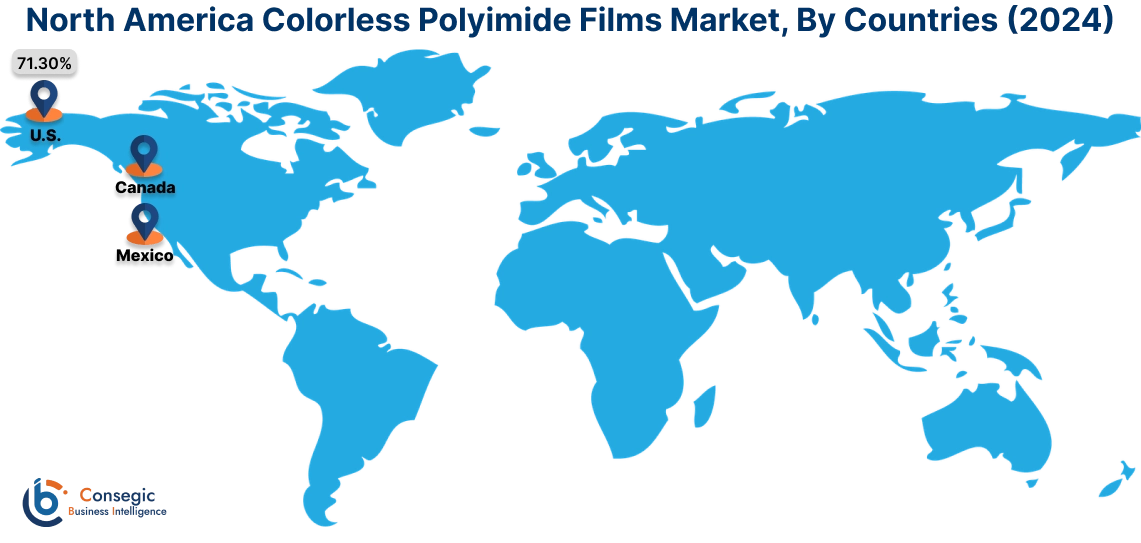
In Asia Pacific, the market is experiencing the fastest growth with a CAGR of 62.0% over the forecast period. In the colorless polyimide films market analysis, fueled by rapid industrialization, urbanization, and expanding electronics and automotive sectors in China, Japan, and South Korea. China dominates the market with extensive use of polyimide films in foldable smartphones, flexible displays, and semiconductor manufacturing. Japan focuses on high-precision applications in consumer electronics and advanced technologies, while South Korea emphasizes its use of OLED displays and flexible electronics. India’s emerging electronics manufacturing sector is also contributing to colorless polyimide films market expansion. However, limited domestic production capabilities in some countries and dependency on imports may hinder growth in smaller markets.
Europe is a prominent market for colorless polyimide films, supported by its strong automotive, aerospace, and industrial manufacturing sectors. Countries like Germany, France, and the UK are key contributors. As per the analysis, Germany drives trends with its advanced automotive sectors, leveraging colorless polyimide films in electric vehicles (EVs) for flexible circuits and battery insulation. France emphasizes their use in aerospace applications, particularly for lightweight, high-temperature-resistant components. The UK focuses on innovative uses in medical devices and wearable technology. However, stringent EU regulations on chemical usage and sustainability may challenge manufacturers in the region.
The Middle East & Africa region is witnessing steady development in the colorless polyimide films market, driven by the increasing adoption of renewable energy and industrial applications. Countries like Saudi Arabia and the UAE are utilizing these films in solar panels and other energy-efficient technologies, aligning with their focus on sustainable energy initiatives. In Africa, South Africa is an emerging market, leveraging colorless polyimide films in industrial equipment and electronics manufacturing. However, limited access to advanced manufacturing technologies and reliance on imports may restrict broader colorless polyimide films market expansion in the region.
Latin America is an emerging market for colorless polyimide films, with Brazil and Mexico leading the region. Brazil’s expanding automotive and electronics sectors drive trends for these films in flexible circuits and battery insulation for EVs. Mexico focuses on the use of polyimide films in electronic components and photovoltaic cells, supported by growing investments in renewable energy. The region is also exploring opportunities in medical devices and wearable electronics. However, economic instability and lack of advanced manufacturing infrastructure may pose challenges to market development.
Top Key Players and Market Share Insights:
The Colorless Polyimide Films market is highly competitive with major players providing products to the national and international markets. Key players are adopting several strategies in research and development (R&D), product innovation, and end-user launches to hold a strong position in the Colorless Polyimide Films market. Key players in the Colorless Polyimide Films industry include -
- DuPont de Nemours, Inc. (USA)
- Kaneka Corporation (Japan)
- S.T Corporation (Japan)
- NeXolve Holding Company (USA)
- Wuhan Imide New Materials Technology Co., Ltd. (China)
- Kolon Industries, Inc. (South Korea)
- Sumitomo Chemical Co., Ltd. (Japan)
- SK Innovation Co., Ltd. (South Korea)
- Toray Industries, Inc. (Japan)
- 3M Company (USA)
Colorless Polyimide Films Market Report Insights :
| Report Attributes | Report Details |
| Study Timeline | 2019-2032 |
| Market Size in 2032 | USD 9,281.99 Million |
| CAGR (2025-2032) | 61.3% |
| By Thickness |
|
| By Application |
|
| By End Use Industry |
|
| By Region |
|
| Key Players |
|
| North America | U.S. Canada Mexico |
| Europe | U.K. Germany France Spain Italy Russia Benelux Rest of Europe |
| APAC | China South Korea Japan India Australia ASEAN Rest of Asia-Pacific |
| Middle East and Africa | GCC Turkey South Africa Rest of MEA |
| LATAM | Brazil Argentina Chile Rest of LATAM |
| Report Coverage |
|
Key Questions Answered in the Report
What is the projected market size of the Colorless Polyimide Films Market by 2032? +
Colorless Polyimide Films Market size is estimated to reach over USD 9,281.99 Million by 2032 from a value of USD 202.55 Million in 2024 and is projected to grow by USD 323.10 Million in 2025, growing at a CAGR of 61.3% from 2025 to 2032.
What are the key drivers for the growth of the market? +
Key drivers include the rising adoption of flexible displays and electronics, advancements in electronic devices, and the increasing focus on lightweight and durable materials.
What challenges does the market face? +
The market faces challenges such as limited awareness and adoption in emerging markets and high production costs of advanced polyimide films.
Which thickness segment holds the largest market share? +
The 10-25 µm thickness segment holds the largest share due to its balance of flexibility and durability, making it ideal for flexible displays and printed circuit boards.
